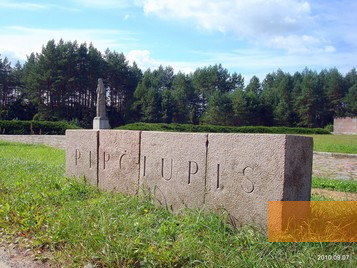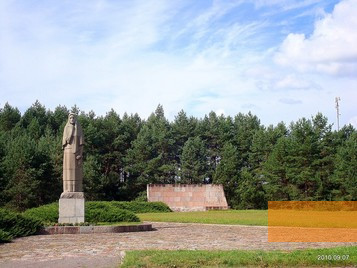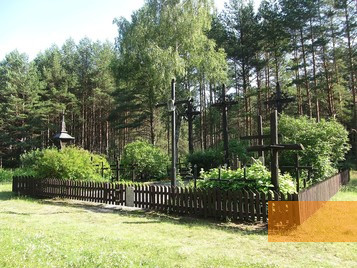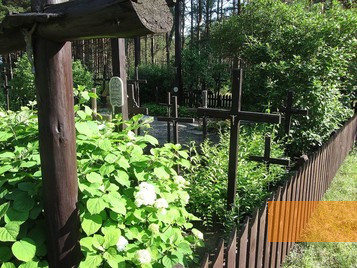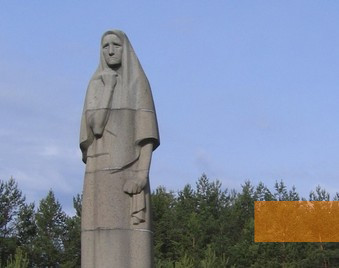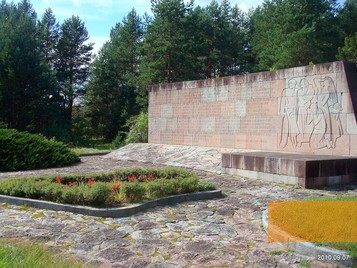In Pirčiupiai (formerly Pirčiupis), a village in the Dzūkija region, a memorial site set up in 1960 remembers 119 residents who were rounded up and burnt alive by German members of the SS and police on June 3, 1944 as part of a »retaliatory measure«.
Pirčiupiai is a village in the Dzūkija region, 45 kilometers southwest of the capital Vilnius. The surrounding forests have been used as hunting grounds by the Lithuanian Grand Dukes since the 16th century. In the early morning of June 3, 1944 pro-Soviet partisans attacked a motorcade of the German Wehrmacht on the road from Vilnius to Eišiškės in a forest about two kilometres south of Pirčiupiai. They killed five soldiers, others were declared later as missing. At eleven o'clock, the 16th SS police regiment, local police and Wehrmacht personnel surrounded Pirčiupiai. They drove the locals out of their homes and looted their food supplies. A few hours later, 58 male and 61 female residents, including 49 children, were locked up in a barn which was then set on fire like other empty houses. The ashes of the victims were not allowed to be buried until June 11, 1944 when they were put to rest in two mass graves in a separate cemetery.
On June 3, 1944, the 16th SS Police Regiment, local police and Wehrmacht personnel surrounded Pirčiupiai. They locked 58 male and 61 female residents, including 49 children, in a barn and set it on fire.
As early as 1947, relatives of the victims and residents of the neighbouring villages had three wooden crosses erected on the memorial cemetery. The inscriptions read: »Rest in peace, brothers and fathers. Rest in peace, mothers and sisters«. In 1956 the government started excavations in Pirčiupiai. Human remains were buried in the cemetery. The following year, the political leaders of Soviet Lithuania, Antanas Sniečkus (1903-1974) and Justas Paleckis (1899-1980), visited the village as part of the first official commemoration ceremony. For this purpose the crosses had to give way to memorial stones made of concrete bearing the inscription: »At these places lie the remains of Soviet citizens who were burned alive by the Hitlerite occupiers and their local helpers«. In 1958, the Council of Ministers adopted a directive to commemorate the victims of Pirčiupiai and the Central Committee of the Lithuanian Communist Party announced a competition for »a memorial to the victims of fascism«. On July 24, 1960, a museum and a memorial complex were inaugurated in a large-scale event under the motto »Pirčiupiai must never repeat itself!« in the presence of 20,000 guests, also from abroad, and high high level politicians. Its centre is formed by the 5.50 metre high granite statue »Motina« (Mother) by sculptor Gediminas Jokūbonis (1927-2006) and a granite wall with the names of the victims. In addition, the cemetery was put into a dignified shape but did not play a ceremonial role in Soviet times.
Pirčiupiai was the first memorial on the territory of the former Soviet Union to be erected for a burnt village. After Lithuania regained its independence in 1990/91, the number of visitors fell drastically and the museum was closed in 2000. In 1995 and 2005, the milestone anniversaries of the end of the war, the respective presidents Algirdas Brazauskas and Valdas Adamkus, who had refused to participate in the military parade in Moscow, visited the memorial cemetery.
Pirčiupiai was the first memorial on the territory of the former Soviet Union to be erected for a burnt village. After Lithuania regained its independence in 1990/91, the number of visitors fell drastically and the museum was closed in 2000. In 1995 and 2005, the milestone anniversaries of the end of the war, the respective presidents Algirdas Brazauskas and Valdas Adamkus, who had refused to participate in the military parade in Moscow, visited the memorial cemetery.
- Name
- Pirčiupių memorialinis ansamblis
- Possibilities
- The memorial complex is located directly next to the A4 B-road and is accessible at any time.


